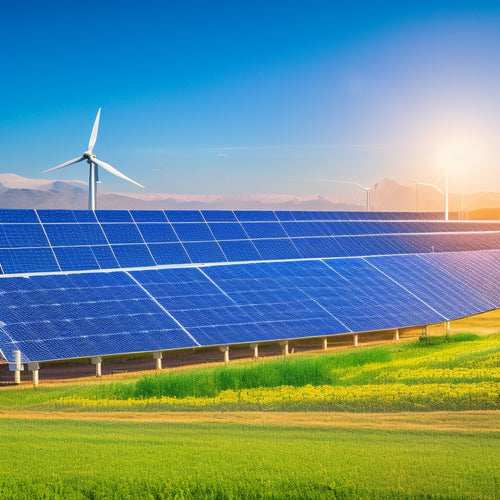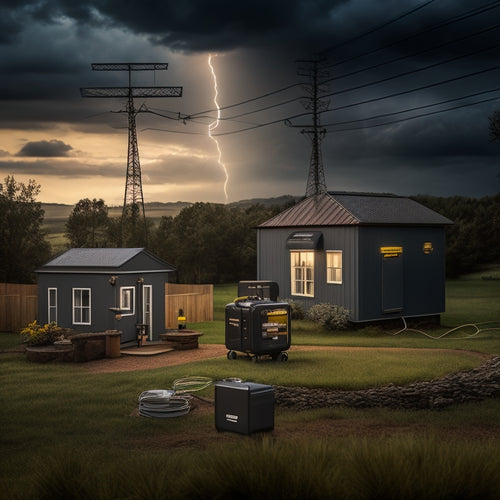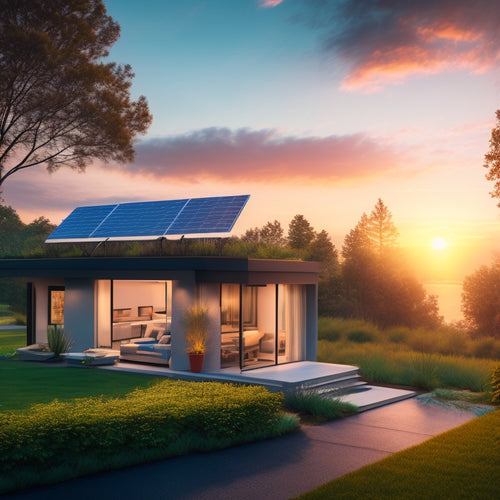
Commercial Solar Panel Installation
Share
You're considering commercial solar panel installation to utilize the financial and environmental benefits of renewable energy, and rightfully so, as it can greatly reduce your energy expenses and carbon footprint. With government incentives like the 30% federal solar investment tax credit, you can offset upfront costs and increase your return on investment. Properly installed systems can eliminate energy bills and provide a sustainable source of power. By optimizing panel placement, angle, and efficiency, you can maximize energy collection and ROI. As you investigate the benefits of commercial solar panel installation, you'll uncover key factors that can further enhance your investment's potential.
The Essentials
- Commercial solar installations can eliminate energy expenses by generating on-site electricity, reducing reliance on the grid and energy costs.
- The federal solar investment tax credit (ITC) offers up to 30% of total installation costs, increasing financial viability for solar investments.
- Proper utilization of government incentives, such as the ITC, can increase overall return on investment and improve corporate sustainability.
- Optimizing panel angle placement and orientation is crucial for maximizing energy harvesting and reducing energy losses during conversion.
- Regular maintenance and performance monitoring are essential for maintaining ideal energy output and ensuring peak performance of commercial solar panels.
Government Incentives Available Now
You can considerably reduce the upfront cost of your commercial solar panel installation by taking advantage of government incentives.
By switching to a clean and renewable energy source, you'll not only reduce your environmental impact but also benefit from energy savings.
The federal government offers tax credits, which can be claimed as a percentage of the total installation cost, while state and local governments provide rebate opportunities to encourage businesses to go solar.
Tax Credits Explained
One of the most notable government incentives for commercial solar panel installation is the solar investment tax credit (ITC). As a business owner, you're eligible for a tax credit of up to 30% of the total cost of your solar panel system. This credit can be claimed against your tax liability, reducing your tax bill and increasing your bottom line.
By installing solar panels, you'll not only benefit from the ITC but also increase your home's value and appeal and contribute to a cleaner, healthier environment. Moreover, with solar panels, you'll be utilizing free, renewable energy from the sun, greatly lowering your monthly electricity bills.
To qualify for the ITC, your solar panel system must be installed and operational by December 31 of the tax year. You'll need to file Form 5695 with your tax return to claim the credit. In addition, you'll need to meet tax credit eligibility requirements, which include owning the system, having a tax liability, and not being exempt from income tax.
The ITC is a federal incentive, and consequently, it's available to businesses of all sizes across the country. By taking advantage of this credit, you can greatly reduce the upfront cost of your solar panel installation, making it more financially viable and increasing your return on investment.
Rebate Opportunities Available
Beyond the solar investment tax credit, various government rebate opportunities are available to further incentivize commercial solar panel installation. By adopting renewable energy systems, businesses can't only reduce their carbon footprint but also promote eco-friendliness and improve their corporate sustainability.
You can take advantage of these financial incentives to offset the upfront costs of your solar investment. To determine your rebate eligibility, you'll need to meet specific requirements set by the government and utility companies. These requirements typically involve the size and type of your solar panel system, as well as your business's energy consumption patterns.
The most notable rebate opportunity is the Rural Energy for America Program (REAP), which provides grants and loan guarantees to rural businesses and agricultural producers.
Additionally, many state governments offer their own rebate programs, often in the form of cash incentives or tax credits. You may also be eligible for rebates from your utility company, which can provide a significant reduction in your energy bills.
Zero Energy Bills
You can greatly reduce your energy expenses by installing commercial solar panels, generating electricity on-site and offsetting your energy consumption.
With a well-designed system, you can eliminate power costs altogether, freeing up resources for other business priorities.
By incorporating solar panel installation costs and considering factors like inverter systems and mounting hardware, businesses can create a customized solution that meets their unique energy needs.
Reduce Energy Expenses
As solar panels generate electricity on-site, they greatly reduce your reliance on the grid, consequently slashing your energy expenses.
With solar power, you're not only reducing your energy costs but also practicing sustainability. By incorporating renewable sources into your energy management strategy, you're taking a significant step towards cost reduction.
A commercial solar panel installation allows you to optimize your energy consumption through load balancing, ensuring you're using the right amount of energy at the right time. Conducting regular energy audits helps identify areas of improvement, and partnering with utility companies enables you to take advantage of demand response programs.
By going solar, you're not only reducing your energy expenses but also increasing your property value through green certifications. In the long term, you'll enjoy significant savings, and with proper maintenance, your solar panels can last for decades.
Eliminate Power Costs
Commercial solar panel installations can catapult your business into a domain of zero energy bills, where the phrase "power costs" becomes an anachronism.
With a well-designed solar panel system, you can generate enough electricity to meet your energy needs, effectively eliminating your reliance on the grid. This means you'll no longer receive hefty power bills, freeing up resources for more strategic investments.
By going solar, you're not only reducing your energy expenses but also achieving energy independence.
You'll be in control of your energy production and consumption, making your business more sustainable and resilient.
A commercial solar panel installation is a sustainable investment that pays for itself over time, providing a significant return on investment through reduced energy costs and potential tax incentives.
Maximum Energy Harvesting
You'll want to guarantee your commercial solar panel installation maximizes energy harvesting by optimizing panel angle placement to capture the most sunlight.
This involves calculating the ideal tilt and orientation for your specific location and system design.
By leveraging high-efficiency solar solutions renewable energy systems and photovoltaic cells, you can greatly increase energy output.
Additionally, investing in efficient energy conversion systems will help you get the most out of the harvested energy.
Optimal Panel Angle Placement
When designing a commercial solar panel installation, it's important to determine the ideal panel angle placement to maximize energy harvesting.
You'll want to take into account the location's latitude, the time of year, and the surrounding environment to optimize energy production.
For a fixed-tilt system, the ideal angle is typically equal to the latitude of the location, with slight adjustments for seasonal variations.
However, if you want to get the most out of your solar panels, you may want to evaluate a solar tracking system. This type of system actively adjusts the panel angle to track the sun's movement, resulting in up to 45% more energy production throughout the day.
Seasonal adjustments are also vital to maximize energy harvesting. During the summer months, the panels should be tilted at a steeper angle to capture more energy, while during the winter months, a shallower angle is more effective.
Efficient Energy Conversion Systems
Optimizing panel angle placement is just the first step in maximizing energy harvesting from your commercial solar panel installation.
Next, you'll want to make sure your system is equipped with efficient energy conversion systems to get the most out of your solar panels. This is where advancements in solar technology come into play. By incorporating high-efficiency inverters and power optimizers, you can minimize energy losses during the conversion process.
These components work together to convert DC power from your solar panels into usable AC power for your business. To further maximize energy harvesting, consider integrating energy storage solutions, such as batteries, into your system.
These solutions enable you to store excess energy generated during the day for use during periods of low sunlight or at night. By optimizing energy conversion and storage, you can greatly reduce your reliance on the grid and enjoy greater energy independence.
Efficiency Ratings Matter Most
When you're evaluating commercial solar panels, you'll come across efficiency ratings that range from 15% to over 20%.
For instance, residential solar panels with high efficiency ratings can considerably reduce electricity bills and carbon footprint solar panels for homes.
These ratings indicate how much of the sun's energy the panels can convert into usable electricity, making them a critical factor in determining your system's ideal energy output.
Panel Efficiency Explained
Among various factors influencing a solar panel's performance, efficiency ratings stand out as an important consideration. When you're evaluating commercial solar panel installation options, understanding panel efficiency is vital. It's a measure of how effectively a panel converts sunlight into electrical energy. You'll often see efficiency ratings expressed as a percentage, with higher numbers indicating better performance.
Recent solar technology advancements have led to significant improvements in panel efficiency. Top-tier panels can boast efficiencies of 22% or higher, while more budget-friendly options might hover around 15%.
When considering panel durability, you should also factor in efficiency. A more efficient panel will likely last longer and require less maintenance, ultimately saving you time and resources.
When comparing different panels, look for the maximum power output (watts) and the surface area required to achieve that output. A more efficient panel will produce more power per unit area, making it a more attractive option for commercial installations where space is limited.
Optimal Energy Output
How much electricity can you realistically expect from your commercial solar panel installation? The answer lies in understanding ideal energy output. A solar panel's efficiency rating directly impacts the amount of energy it produces.
With high-efficiency panels, you can generate more power per unit area, reducing the overall system size and cost.
To maximize energy output, consider energy storage solutions that allow you to store excess energy generated during the day for use during periods of low sunlight or at night. This guarantees a stable and reliable energy supply, giving you more control over your energy usage.
Regular system maintenance is also vital in maintaining ideal energy output. Dirt, debris, and faulty components can greatly reduce energy production.
By performing routine inspections and maintenance, you can identify and address issues promptly, guaranteeing your system operates at peak performance.
Higher ROI Than Wind
You'll find that solar panels consistently outperform wind turbines with regard to energy yields, generating more electricity per unit of installed capacity.
This is because solar panels can operate at or near their peak capacity for a larger portion of the day, whereas wind turbines are often idle due to variable wind speeds.
As a result, commercial solar installations typically offer higher returns on investment (ROI) than their wind-powered counterparts.
Higher Energy Yields
Solar panels positioned at an ideal angle and orientation can employ more energy from the sun, resulting in higher energy yields.
You can maximize your energy production by optimizing the installation's layout, considering factors like shading, panel tilt, and direction. Implementing solar tracking systems allows your panels to adjust their angle and orientation in real-time, guaranteeing you're capturing the most energy possible throughout the day.
Performance monitoring is also vital in achieving higher energy yields. By tracking your system's performance, you can identify potential issues and make data-driven decisions to optimize your energy production.
This includes monitoring individual panel performance, inverter efficiency, and overall system output. With this data, you can pinpoint areas for improvement, schedule maintenance, and ascertain your system operates at peak performance.
Frequently Asked Questions
Can I Install Solar Panels on My Old or Historical Building?
When preserving historic buildings, you'll need to guarantee that solar panels won't compromise roof integrity or contradict historic preservation guidelines, so consult with local authorities and experts to determine the best installation approach that respects your building's heritage.
Do Solar Panels Work Well in Areas With Frequent Shade?
You're probably imagining a perpetual twilight, but even with frequent shade, solar panels still capture energy! While shaded performance takes a hit, energy efficiency remains decent, and clever system design can mitigate losses, ensuring you still reap the benefits of renewable energy freedom.
Are Commercial Solar Panels Compatible With Existing Electrical Systems?
You'll find that solar panels seamlessly integrate with existing electrical systems, requiring minimal grid integration and occasional electrical upgrades to guarantee a smooth, efficient shift, ultimately granting you the freedom to utilize renewable energy.
How Long Does a Typical Commercial Solar Panel Installation Take?
You're on the cusp of utilizing renewable energy, but first, you wonder how long the wait will be. The installation timeline unfolds in distinct project phases, typically spanning 3-6 months, depending on complexity and permits, before you're free to bask in self-sustaining glory.
Can I Install Solar Panels on a Flat or Uneven Roof?
You can install solar panels on both flat and uneven roofs, but it's essential to choose the right mounting system; for flat roof installation, ballasted or attached systems work well, while uneven surface solutions like tilt kits and adjustable clamps provide flexibility.
Final Thoughts
As you invest in commercial solar panel installation, imagine leveraging the power of the sun to fuel your business, slashing energy bills to zero, and reaping maximum returns on your investment. With government incentives in place, the time to act is now. By prioritizing high-efficiency ratings, you'll reveal the full potential of solar energy, outperforming wind power in ROI. As the sun rises on a fresh chapter of sustainable energy, position your business at the forefront of the revolution.
Related Posts
-

The Role of Battery Monitoring Systems in Renewable Energy
Battery monitoring systems play an essential role in renewable energy by enhancing system longevity and optimizing pe...
-

Key Components of a Reliable Emergency Power Supply System
A reliable emergency power supply system requires several key components. You need proven performance metrics to guar...
-

The Future of Residential Energy Storage
The future of residential energy storage looks promising and cost-effective for you. With lithium-ion battery prices ...


